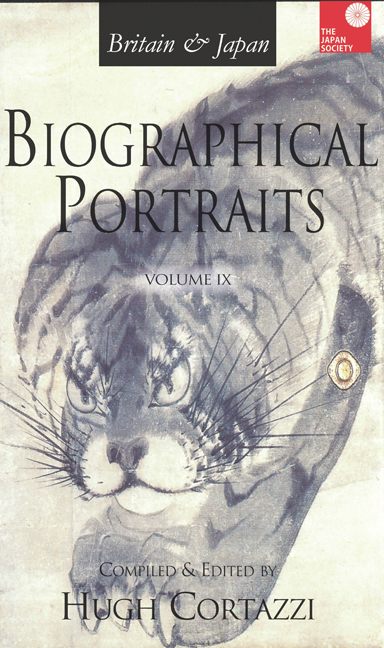Book contents
- Frontmatter
- Contents
- Introduction
- List of Contributors
- Index of Biographical Portraits in Japan Society Volumes
- PART I JAPAN IN BRITAIN: THINGS JAPANESE
- PART II BRITAIN IN JAPAN: TRADE
- BRITISH ACTIVITIES
- MISSIONARIES
- MUSIC, DRAMA AND FILM
- EPISODE
- PAINTERS
- JOURNALISTS
- JAPANESE WOMEN PIONEERS
- PART III SCHOLARS AND WRITERS: JAPANESE
- BRITISH
- PART IV POLITICIANS AND OFFICIALS: JAPANESE
- BRITISH OFFICERS
- BRITISH JUDGES AND A DIPLOMAT
- BRITISH POLITICAL FIGURES
- Index
18 - John William Fenton (1831–1890) and the Japanese National Anthem Kimigayo
Published online by Cambridge University Press: 30 April 2022
- Frontmatter
- Contents
- Introduction
- List of Contributors
- Index of Biographical Portraits in Japan Society Volumes
- PART I JAPAN IN BRITAIN: THINGS JAPANESE
- PART II BRITAIN IN JAPAN: TRADE
- BRITISH ACTIVITIES
- MISSIONARIES
- MUSIC, DRAMA AND FILM
- EPISODE
- PAINTERS
- JOURNALISTS
- JAPANESE WOMEN PIONEERS
- PART III SCHOLARS AND WRITERS: JAPANESE
- BRITISH
- PART IV POLITICIANS AND OFFICIALS: JAPANESE
- BRITISH OFFICERS
- BRITISH JUDGES AND A DIPLOMAT
- BRITISH POLITICAL FIGURES
- Index
Summary
INTRODUCTION
JOHN WILLIAM FENTON (1831–1890) was the bandmaster of a British Army regiment, stationed in Yokohama in the early Meiji period. He was the first person to teach wind instruments to a Japanese military band and is regarded in Japan as ‘the father of wind band’. Fenton continued his instruction as one of the many British advisers who were employed by the Japanese Imperial Navy. It was the beginning of the systematic education in Western music, and part of a wider effort to introduce the naval system modelled after the British. He even taught Western music to the musicians of the Imperial Court, who had played traditional court music for nearly a thousand years. Fenton is also known as a composer of the first version of the Japanese national anthem, Kimigayo. He brought to the Japanese the concept of a national anthem when the Meiji government was struggling to establish a centralized nation state. Fenton was the first person to teach the Japanese Western music in a systematic manner. He was a pioneer in musical exchanges between Japan and Britain and thus played a critical role in the introduction of Western music to Japan.
A wind band arrived for the first time in Japan on board the Dutch ship Palembang in Nagasaki in 1844. It was followed by the band which accompanied Commodore Perry when he landed in Kurihama (approx. 30 km south of Yokohama) in 1853. Japanese artists made detailed illustrations of various Western wind instruments used by the band members. In the following year the first British naval flotilla under Rear Admiral Sir John Stirling arrived in Nagasaki; they made for the shore in six rowing boats, led by a band that played a medley of English airs, concluding when they finally landed with God Save The Queen. This was almost certainly the first time British music was played in Japan.
Alarmed, by the increasing number of visits by foreign military vessels, the Tokugawa Shogunate (Bakufu) felt the need to modernize its own navy. The Naval Training Institute, with Dutch instructors, opened in Nagasaki in 1855. Signal calls, using military drums, were included in the curriculum. The Japanese trainees were said to have practised the instrument enthusiastically. Although the Institute was closed in 1859, this prepared the ground for the introduction of fife and drum bands attached to the armed forces.
- Type
- Chapter
- Information
- Britain & Japan Biographical Portraits Vol IX , pp. 207 - 225Publisher: Amsterdam University PressPrint publication year: 2015



